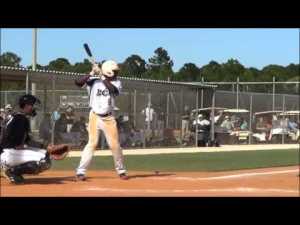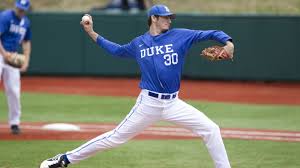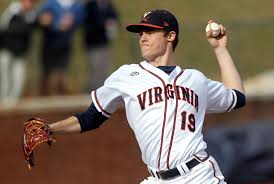Early 2015 MLB Mock Draft: Part 1
Like Michael Jordan 20 years ago, like Mario Lemieux 15 years ago, I’m back. This summer, I worked with a collegiate summer league team in the New England Collegiate Baseball League. You can read about that in my season long project blog here.
Now that I’m officially back, I’m going to start off by doing a very very early mock draft. While in real life, the parameters of a selection are based on best player available or signability, the parameters behind my choices are based on three factors: Organizational need (That is, in the top 20 prospects list) general manager tendencies, and, if those two fail to yield a top selection, best player available. So, without further delay, here is the 2015 MLB mock draft.
1. Arizona Diamondbacks: Daz Cameron, OF, Eagle’s Landing High School, Georgia
Ten years ago, the Diamondbacks were in the exact same situation they are now. With the first pick that year, they took Justin Upton, who spent six productive years with the team, with two All-Star appearances and a Silver Slugger. Could it be possible the D-Backs do the same thing ten years later?
Daz, who is the son of former MLB outfielder Mike Cameron, is an exceptional athlete. His stroke is smooth and professional, allowing him to hit to all fields. He clocked in a 6.61 60 yard dash, giving him the speed to justify himself as a top of the order threat, as well as be able to contribute defensively. While Daz doesn’t have the body for the big leagues yet, with some bulking up, he could become a very powerful athlete.
There are concerns that an average junior season could drop his stock, but he does have one more year of high school to go. He’s been compared to Derek Hill, who many thought was one of the better outfielders in last year’s prep class.
If Cameron develops at the speed that Upton developed, he could be in the Majors by 2017, allowing him and Paul Goldschmidt to establish one of the premier 3-4 combos in the NL West.
2. Houston Astros: Phil Bickford, Pitcher, College of Southern Nevada
The longstanding pillar of high school players waiting three years to become draft eligible is starting to show cracks, as evidenced by three top level prospects electing to leave Division 1 baseball for junior college. Three of those players are top level talent: Brady Aiken, formerly (if ever) of UCLA, Mac Marshall, formerly, (if ever) of LSU and Phil Bickford, formerly of Cal State Fullerton.
Bickford has been here before, back in 2013, he was the tenth pick in the 2013 draft by the Toronto Blue Jays and elected not to sign. He spent a year playing for the Titans, then proceeded to dominate the Cape Cod League, bringing the YD Red Sox a championship. Perhaps it was being named a top five prospect in the Cape that encouraged him to alter his eligibility.
Exposition aside, Bickford has clearly shown major improvement from when he was drafted back in 2013. His fastball has more life in it, going from a low to mid 90’s pitch and he’s more of an athlete than he was at Oaks Christian. The question is whether or not he made the right choice in his college, as he opted for the unfamiliarity of the College of Southern Nevada as opposed to the familiarity of Cypress Junior College, where his summer league coach works.
While the Astros have an impressive arsenal of pitchers waiting in the wings with Mark Appel, Lance McCullers, and Mike Foltynewicz, losing Brady Aiken last year should have the Astros scrambling to find his replacement. Even though Aiken is eligible for this draft, the Astros would rather not deal with the headache again, and would go for Bickford, who has not shown any issues with his arm.
3. Colorado Rockies: Michael Matuella, P, Duke
So it’s finally happened, the other Duke sports are catching up to lacrosse and basketball. All joking aside, the Blue Devils have done an excellent job in developing pitchers for two of the past four drafts. Marcus Stroman has exceeded expectations and become a viable starter in the Blue Jays rotation, while Matuella has become one of the bigger surprises in terms of smaller college pitchers.
Matuella is much bigger than Stroman was, with a 6’6″ frame, and he has a good variety of pitches, even if he uses his fastball almost exclusively. This isn’t a problem, as Matuella’s fastball does have plenty of life in it, allowing him to get batters out. The one issue that Matuella has is his health, as he was forced to miss summer ball with a back issue, although he has since then resumed throwing.
The Rockies would greatly benefit from a homegrown rotation that features the likes of Jon Gray, who is considered one of the fastest pitchers in the minor leagues, and Kyle Freeland, who has proven he could handle big competition in summer back in 2013. Having Matuella in that rotation will provide the Rockies with plenty of rotational stability and. should Troy Tulowitzki still be here by next June, convince him to stay, allowing the Rockies to determine their eventual successor.
4. Texas Rangers: Brady Aiken, P Yavapai (AZ) Junior College
It’s not a matter of whether or not Brady Aiken can pitch, rather it’s a matter of whether or not he is making the smart choice in going to junior college. Aiken was talented enough to be the number one pick this past June, but a physical revealed a UCL that was almost gone, leading to the Houston Astros purposefully lowballing him, as well as high level draft picks Jacob Nix and Mac Marshall.
History aside, Aiken does have the opportunity to jump back in, and there are 29 teams that don’t know anything about the lefty outside of his potential and the UCL issue. He has stuff that most college pitchers would envy, and his health has been good.
The Rangers would love to make their in-state rival pay dearly, and drafting Aiken and dealing with his camp the correct way would certainly serve as an indicator that the Rangers are serious about rebuilding a rotation that hasn’t looked good since 2012.
5. Houston Astros: Brendan Rodgers, 2B/SS/OF Lake Mary High School, Florida
Given the Astros’ ability to stack up big name, almost immediate non-first round contributors in the past three drafts, see Tony Kemp, AJ Reed, Derek Fisher, as well as their current projects, (Carlos Correa, Colin Moran, Delino DeShields) and of course, their top pitching prospects (Mark Appel, Lance McCullers), it’s almost impossible to tell what they should use their other pick. Having already given them a top left handed pitcher in Phil Bickford, I decided to have them pick Brendan Rodgers. Rodgers is a versatile player, having played the middle infield, as well as some outfield.
It’s almost a given, however, that a high school shortstop is going to move to another position. We saw it with Manny Machado, Gavin Cecchini of the Mets has been moving around a bit, etc.
Rodgers does have a bat on him. as he hit .397 with 8 long balls this past season. He’ll be an interesting player to watch this year, as some scouting websites have him ranked as the top player in this year’s draft.
6. Minnesota Twins: Nathan Kirby, LHP Virginia
Nathan Kirby had an interesting year, being a part of the 2014 College World Series runner up, and then pitching, albeit briefly, in the Cape Cod League. Kirby is the latest in a line of Virginia aces who have potential to be reliable big league rotation options. His offerings have some room for improvement, and his mechanics are easy to figure out, thanks to his college pitching coach. Still, as far as left handed college pitchers go, Kirby stands a chance to be the best in this year’s class.
Minnesota’s first round draft history has been exclusively prep for the past three seasons, with Byron Buxton, Kohl Stewart and Nick Gordon representing the future of the Twins. Assuming the competitive target date for the team is 2017, now might be the perfect time to invest in a college pitcher.
7. Boston Red Sox: Walker Buehler, RHP Vanderbilt
To say that the Red Sox have plenty of top heavy talent ready to replace the old guard is a pretty accurate assessment. However, with the new talent that comes up or is traded, there must be an adequate replacement.
Walker Buehler may not have the ideal pitcher’s body, nor may he be as celebrated as his former teammate Tyler Beede, but as far as workman starters go, he’s a valuable asset. Buehler has been big game tested, he helped the Commodores win their first College World Series last season, and he has the composure to last long in games. His toolbox contains a low to mid 90’s fastball that does have movement, especially at the end.
Buehler does deserve a shot as a mid to end rotation starter, and while Boston may be crowded in terms of pitchers now, don’t be surprised if a few key moves allows Buehler to be a potential hotshot prospect.
8. Chicago White Sox: Ian Happ, 2B/OF Cincinnati
Chicago’s system may have gotten a boost in Carlos Rodon, but odds are that the NC State hurler is going to be in the Majors by the end of 2015 Spring Training. While the Sox would love to develop another top caliber starter, for me, it would be a good idea for them to consider developing some hitting prospects.
Ian Happ is like a taller poor man’s Jose Altuve. He’s undersized for his position, but he does have the tools to be considered a legitimate prospect. He is versatile, although most scouts think that he’ll fit in the outfield professionally. He knows how to hit, and most of his hits are clear cut.
Happ greatly benefited in summer ball, earning an All-Star selection, and he will definitely be a star in what is considered an average baseball conference. WhIle I would love to see him and 2013 first round pick Tim Anderson form a longtime double play combo, even if Happ does end up in the outfield, he will be a good fit in Chi-town.
9. Chicago Cubs: Justin Hooper, LHP De La Salle High School, California
When the Cubs took Kyle Schwarber 4th overall back in June, people’s heads exploded. When they took Jake Stinnett in the second round, the sound that came from Studio 42 was a big “Huh?” Fortunately the Cubs finally drafted a high ceiling prospect in Carson Sands in the third round.
While the Cubs’ cost effective draft strategy has (mostly) paid off (Stinnett was rarely used and could not be judged quite yet) it’s time for the Cubs to get with the times and add a rotation that could supplement what many believe is going to be one of the scariest homegrown offenses in baseball.
Justin Hooper is a left handed California prep hurler with stuff that could put him on an SEC pitching staff. He does have the size and the tools to succeed, what he needs is work. Should Hooper develop properly, he and Sands could actually anchor the Cubs rotation a few years down the line.
10. Philadelphia Phillies: Alex Bregman, SS/2B LSU
While it’s pretty obvious that JP Crawford is the heir apparent for when Jimmy Rollins does eventually retire, (my over/under is 2016), the question remains how long his double play partner, Chase Utley will be around. While Utley did bounce back a bit this year, it’s time for the Phillies to start developing another infield talent.
Alex Bregman has been one of the more celebrated collegians, especially since he was an All American pick in his freshman year. Bregman may not have been as good in his sophomore year, dropping his draft stock from top 5 to top 10, but given his potential, there is bound to be at least one team interested in nabbing him at a slot discount.
Bregman is a reliable producer who will be a solid offensive contributor if used well, and the Phillies would greatly benefit adding him to a roster that would include his Tigers teammate, Aaron Nola.
11. Cincinnati Reds: DJ Stewart, OF Florida State
When I was looking for a suitable picture for DJ Stewart, one of the first things I noticed was his build, and I’ll be honest, he looks like he could be catching passes from Jameis Winston on Saturdays. That being said, Stewart is a tank. He’s atypical for a power hitter, drawing more walks than strikeouts, and he’s actually got the pedigree that could get him far, as his dad played in the San Diego Padres’ system.
While the Reds have a solid outfield now, keep in mind that you don’t draft for need. That being said, chances are that Jay Bruce may be gone in a couple years, and Ryan Ludwick isn’t getting any younger, leaving Billy Hamilton, Phil Ervin, and Jesse Winker as the future of the Reds’ outfield, which to be fair, isn’t a bad thing, but again, power wise, these guys won’t scare many people. Assuming Joey Votto will be hitting his decline, it may be a good idea to get Stewart as power insurance and let him develop as the Reds’ future source of power.
12. Miami Marlins: Chris Betts, C/1B, Wilson High School, California
It’s safe to say that the Kyle Skipworth experiment was a colossal failure, and while JT Realmuto may be the future of the position, the jury is still out after an 11 game sample in which he struck out 8 times in 29 at-bats. There may be a stigma around high school catchers, that is, you don’t see many of them playing Major League Baseball as catchers, see the recent position changes for 2012 picks Stryker Trahan and Clint Coulter.
Betts, whose high school does have a reputation for producing top talent (Hall of Famer Bob Lemon, former first overall pick Jeff Burroughs and his son Sean, as well as 2008 Twins first rounder Aaron Hicks come to mind,) while still a bit of a project, does have the projectability to remain behind the plate, with the option to move to first base if it gets crowded. Betts can hit, however, a plus for any catching prospect, and that will help him advance through the system.
13. San Diego Padres: Carson Fulmer, RHP Vanderbilt
Marcus Stroman has essentially blown the stigma that short pitchers can’t succeed out of the water. That being said, Carson Fulmer is close to Stroman in both body and ability. He can throw a fastball as fast as 97 MPH, and he has enjoyed a high strikeout rate throughout his college career. Fulmer’s also an interesting mound presence, utilizing a very physical delivery that draws parallels to a tennis player.
Delivery and height aside, Fulmer is battle tested, having been a part of the 2014 College World Series run as well as being a key part of Team USA. If the Padres draft him and develop him properly, he could prove to be a better alternative to Casey Kelly, and form a talented pitching trio with Odrisamer Despaigne and Max Fried.
14. Tampa Bay Rays: Mike Nikorak, Stroudsburg High School, Pennsylvania
Tampa Bay may have left their Devil Rays struggles behind long ago, but they are in the midst of a rebuild, and in rebuilding, they need to figure out who will be their staff leader down the road.
While prep pitchers from the North are rarely, if ever heard of in the first round, if they are effective, they can be solid rotational options. Nikorak, a Pennsylvania product with a commitment to Alabama, may be a tough sign, though, as he is committed to the Crimson Tide as a quarterback. Nonetheless, his size (6’5″) and fastball speed (97) will definitely entice any team, even the small market Rays, to sign him. He’d be an excellent fit in a rotation that could feature up-and-comers like Taylor Guerrieri and Alex Colome.
15. New York Mets: Dansby Swanson, SS/2B, Vanderbilt
I think it’s clear that so long as the person in the New York Mets’ GM chair is Sandy Alderson, you can forget about the possibility of the Mets drafting a pitcher in the first round. There are traceable assets that the Mets have that can get top of the line pitchers. Just look at the trades Alderson has made the past three seasons.
Moving on, however, the thing that Alderson needs is a shortstop. Even if Gavin Cecchini and Amed Rosario are developing nicely, one or both likely could be packaged in a deal for a playoff piece, should the Mets be in contention. And even if they aren’t traded, Wilmer Flores or Dan Murphy could, and that leaves a gaping hole at shortstop, given the unreliability of Ruben Tejada.
Swanson has made headlines in college already, and Alderson likes positive news from college players. Already proven as a big game guy, he’s got the fielding ability to play shortstop and stay. Swanson also has the speed and bat to be, at best, a 2 hitter. Given the fact that most of the Mets’ talent from the past few drafts should be in the majors by 2015-16, expect a guy like Swanson to work hard to be a part of that team.
———
Part two will be coming along shortly.















Carson Sands was a 4th round pick of the Cubs. They took Mark Zagunis in the 3rd last year.